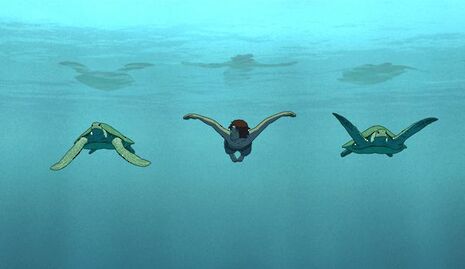Review: ‘The Red Turtle’ of Life and Death
Jack Wearing and Emily May take a trip to see a charming animation sublime in its audio and its visuals, touching on the wider existential questions of what it means to be human.

JW: It's difficult to know what to say about The Red Turtle, since it's formally very different to almost every film I've seen. Perhaps the closest is The Tale of Princess Kaguya, which, not coincidentally, was directed by Isao Takahata, who worked on this film as artistic producer. I think both films resemble a myth or a parable, The Red Turtle radically so. In some ways it's a very sparse film; there is no dialogue aside from some inarticulate expressions of feeling, and there are many wide shots that are almost empty. Yet at the same time it seems full of meaning, while resisting any particular interpretation. Like the black eyes of the eponymous turtle in one of the film's few close-ups, there's something mysterious and inscrutable about this story.
“It washes over you, and your body says, ‘Yes, that's what it's like. That's what it's like to be human.’”
EM: I think it's a film fundamentally at ease with itself, and with its subject matter. It takes its time, but it isn't without conflict, nor is it plotless. It's concerned with life itself: a cyclical motion between generation, growth, loss and death – and Woman as Nature at the centre, its driving force. It's unfashionably humanistic. But insofar as I am willing to posit a distinctively and essentially human condition, myth-making is at its heart. I'm not sure that The Red Turtle is resistant to interpretation, although it hardly cries out for it. It's not attention-seeking like that. It washes over you, and your body says, “Yes, that's what it's like. That's what it's like to be human.”
JW: For me it does call out for interpretation. Why does he dream of a string quartet, or of flight? (The latter is perhaps obligatory given that Ghibli co-produced this.) What does the turtle represent, or the circular bottle? Perhaps I'm looking at it the wrong way, because at times I got the impression you got too – especially in the scenes of storm and tsunami, and their bleak aftermath. The sound design is terrific, both in those incredibly immersive storm scenes and in the quieter moments. I felt that the film's world had a lot of character, especially with the crabs and baby turtles. I certainly think it's worth seeing, and the number of production companies listed at the start is a depressing reminder of how difficult it is to get a film made that's as unique as this one. But I think for me ‘what it's like to be human’ can't be expressed in such general terms, not in all its disorder and specificity.
EM: The bottle is an important part of the narrative surrounding the child. He rejects the confinement of the island for the open sea: the bottle offers the promise of something beyond. His father eventually rejected the sea for a simple life of love and subsistence. He's filled with remorse for his violence against the obstacle to his escape. The string quartet hallucinations are really lovely moments of synchronisation between the score and pictures. In a film with so little dialogue, the score must function as more than background filler. It's an active component of the film as a communicative whole. I think they're taunting him – tricking him into thinking ‘civilisation’ is within reach. But before long he purposively turns his back on the civilisation he knew. That spoke to me anyway
 Comment / Plastic pubs: the problem with Cambridge alehouses 5 January 2026
Comment / Plastic pubs: the problem with Cambridge alehouses 5 January 2026 News / New movement ‘Cambridge is Chopped’ launched to fight against hate crime7 January 2026
News / New movement ‘Cambridge is Chopped’ launched to fight against hate crime7 January 2026 News / Uni-linked firms rank among Cambridgeshire’s largest7 January 2026
News / Uni-linked firms rank among Cambridgeshire’s largest7 January 2026 News / Cambridge businesses concerned infrastructure delays will hurt growth5 January 2026
News / Cambridge businesses concerned infrastructure delays will hurt growth5 January 2026 Features / Who gets to speak at the Cambridge Union?6 January 2026
Features / Who gets to speak at the Cambridge Union?6 January 2026









